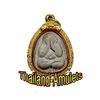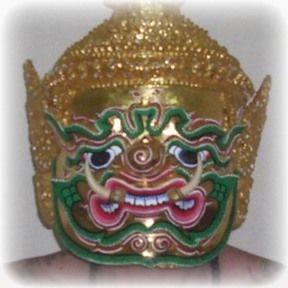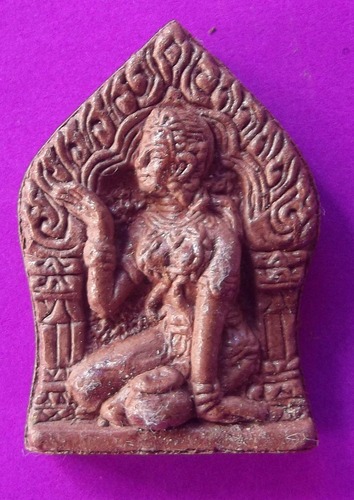

Thailand Amulets
Thai Buddhist and Magical amulets for Wealth, Health, Love and Happiness.
Vast Selection of Amulets
We have a vast selection of over 4000 different kinds of Sacred Amulets and Bucha Items, including Buddha Image, Loi Ongk statuettes, Buddhist Monk Coin Amulets, Takrut Charms, Nam Man Prai Oils, Mai Kroo Wands, Mitmor Ritual Knife, Lek Lai Kaya Siddhi Elemental Substance, Kumarn Tong, Gambling Amulets, Mae Nang Prai, Muan Sarn Sacred Powder Amulets, Palad Khik, Animist Charms, Necromantic Amulets, Buddhist, Animist, Brahman and Necromantic Amulets.
Mae Nang Kwak Maha Lap - Nuea Pong Prai Roey Chin Wan Saw Hlong 2545 BE - Phu Mor Nak Paetch Saeng Keow
Mae Nang Kwak Maha Lap Merchants Deity in sacred Prai Powders and 'Wan saw Hlong' herb sprinkled on the rear face, for intense Maha Sanaeh and Metta Mahaniyom attraction.

Size; 3.0 Cm High x 2.0 Cm Wide
The rear Face has Buddhist Kata inscribed in Ancient Khom inscribed around the surface. This brings both Metta Mahaniyom and Kong Grapan Klaew Klaad power to the amulet. Ratre wan Saw Hlong Herb has been sprinkled into the Muan Sarn. This amulet is yet another Extremely Beautiful, Sacred, Powerful and Classic Masterpiece Amulet. A future rarity, which is most certain to become the subject of many a magazine article, and the pride of many a collector's showcase.
In the Creation of his amulets, Phu Mor Nak chooses the richest, rarest and most magically powerful Powders, Sacred Herbs, Woods and ingredients, to mix for these amulets. Phu Mor Nak explains, That it is not important which edition you rent, because he is still alive, and every edition is special in its own individual way, and never repeats its design exactly, and each amulet is empowered with exactly the same loving attention and meditative prowess.

How to Rever Nang Gwak
To Bucha Nang Gwak, One should use 5 incense sticks and offer flowers (preferably jasmine), red syrup drink (‘Nam Daeng’). Some water, and also some sweets and rice as offerings.
Light the incense, candles, and offer the flowers and drinks. Then Say “Namo Dtassa Pakawadto Arahadto Sammaa Samputtassa” 3 times, and bow three times to Buddha before you begin chanting Kata Nang Gwak.
Kata Nang Gwak
-
Om Sriwichay Gangwian
-
Phu Jao Khao Khiaw Mii Luuk Kon Diaw Cheu Naang Gwak
-
Chaay Hen Chaay Rak Hying Hen Hying Tak
-
Tak Tuan Naa Puak Paanichaa Paa Guu Bpai Kaa Terng Mueang Maen
-
Guu Ja Bpai Kaa Hua Whaen Gor Dai Wan La Saen Tanaan
-
Guu Ja Kaa Saarapadgarn Gor Dai Doey Klong
-
Guu Ja Kaa Tong Mua Rai, Gor Dai Dtem Haab Piang Wan Nii Bpen Rooy
-
Saam Haab Ma Ruean Saam Duean Bpen Saedtii Saam Bpii Bpen Por Kaa Sampao
-
Pra Rasii Puu Bpen Jao Bprasit Hai Gae Luuk Kon Diaw Swaaha.
Use this Kata when you are going to sell things, or in your place of business in the morning. Here is a slow and clear pronunciation of the above text, exactly as it is written;
Who was Nang Kwak?
The legend of Nang Kwak, is something that occurred a long time ago, before or during the time when Buddhism was beginning to spread, about 2500 years ago. The legend tells that, in the Indian province of Sawadtii in the small town of Michigaasandhanakara (มิจฉิกาสันฑนคร)There was a married couple whose names were Mr. Sujidtaprahma (สุจิตตพราหมณ์ ) and Mrs. Sumanta (สุมณฑา), who had a daughter named Supawadee (สุภาวดี).They were merchants who sold small amounts of wares on the markets, only earning just enough to maintain their small family from day to day.
One day, they were discussing their hopes and dreams for the future, and decided that they should try to expand their business to make more profit and begin to think of being able to save something for their old age; as a result of this conversation, they decided to try to afford to buy a "gwian" (cart) in order to use to travel with and sell their wares to other towns and villages, also then bringing wares from the other towns to sell in Sawadtii and Michigaasandhanakara when they returned.
Sometimes, Supawadee their daughter, would aske to tag along for the ride, and help them. One day, as Supawadee was helping her parents to sell wares in a distant town, she was lucky to be able to hear a sermon by Phra Gumarn Gasabatera (พระกุมารกัสสปเถร); she was som conviced and moved by his sermon, that she took refuge in the Triple Gem. When Gasabatera saw her faith and devotion, he collected all his powers of thought and concentration of an Arahant* (for indeed Phra gasabatera was and Arahant*), and bestowed blessings of good fortune and luck in salesmanship on Nang Supawadee and her Family. In addition, Phra Gasabatera increased the power fo the blessing to make the magic stronger every time that Nang Supawadee would attend and listen to Dharma teachings with such devotion as she had this time.
Nang Kwak In the next town they went to to sell wares, Nang Supawadee recieved the opportunity to listen to the preachings of Phra Siwaliitera (พระศิวลีเถร), who was also in the business of wandering around preaching the Dharma as taught by Lord Buddha Sakyamuni. Nang Supawadee received teachings from this master, and thus became extremely well versed and knowledgeable in Dhamma. Phra Siwalii bestowed blessings of Metta upon her for her diligent efforts to follow and understand the practce of Dharma.Phra Siwalii tera was different from normal beings and had a strange event marking his birth; namely that, he remained in his mother's womb for a period of 7 years 7 months and 7 days before being born in the world.This cause Phra Siwali to be endowed with extremely strong mind powers, which, when he concentrated all his mental power and effort to bestow the Metta blessing upon the young Supawadee, the result was an especially strong effect to the blessing he gave.
Due to these blessings gained from the two saints, it came to notice that every time Nang Supawadee came along for the rinde on her parents' cart, sales were fantastic and all the goods were always sold in no time at all! As the when Nang Supawadee did not accompany them on their market sounds; sales were pretty meager in comparison. Her parents decided that their fortune would be best if they had their daughter Supawadee accompany them always on their sales rounds because they believed that the good fortune was to do with the blessings and merit she had with her.Thsi broght such great fortune upon the family, that in a short time they became extremely wealthy merchants.
Once they had already become pretty wealthy, Mr. Sujidtaprahma received the opportunity to hear some Dharma teachings from the Lord Buddha himself; he was filled with faith and reverence, and as a result of this, began to practce Dharma practce and reached the attainment of Sotapanna ( โสดาบัณ- Soedaaban, in Thai) which is otherwise known as "Stream Enterer".Supawadee's father then donated a park called "Ampatagawan" (อัมพาฎกวัน), for the Bhikkhus to rest and take shelter in, as well as building a Vihara (shrine and salon) for the Monastics, as a temple withing the grounds.The temple was named "Wat Machigaasandharaam" ( วัดมัจฉิกาสัณฑาราม), Phra Sutamma Tera was invited to be Abbot of the temple. Mr.Sujidtaprahma, who was very well knowt for being a person whou would g out of his way to help others, and a good hearted generous fellow, would ask people on his sellig rounds if anyone was going the same way and wished to hitch a ride with him. Sometimes there would be as many as a thousand people wishing to accompany him, which he never refused, always fulfilling their wishes, regardless of if they were followers of the Buddha like himself or not.The many people who got to ride with him noticed the amazing power of Metta Mahaniyom of his daughter Nang Supawadee, whose blessings had caused her parents to become wealthy merchant moguls, and thus began to worship her as a cause of good fortune in selling and business matters. After many years, Sujidtaprahma and his wife Mrs Sumanta became old and passed away - their blessed daughter Supawadee also became old and eventually had to pass on to the next life, and left her body behind.
But her legend clived on in the hearts for all the people who had adopted her as the patron saint and magical deva of all merchants, praying to her and making offerings to increase merit and receive great fortune in business dealings.Anyone wishing to have good luck in ther sales would seek oout an image or statue of Nang Supawadee and make Pojja offerings to her, inviting her spirit to come and reside in the statue or image, and bring them luck, as Supawadee had always done whilst riding on her father's cart.
All of 4 different castes of the Indian Hindu caste system adopted the practice; Brahmins, Royalty, Medics, and even Sudhras were seen to worship and respect Nang Kwak. The practce of making Bucha to Nang Kwak became ever more widespread du to tales of many merchants practising Bucha Nang Kwak, and becoming extremely wealthy; this caused people in all four directions of the compass to adopt the practce. The practce of praying to Nang Kwak was adopted by the Thais as Buddhism and the Brahmin faith came to Thailand, and is as proliferant today as it ever was in ancient times! The Brahmins, who are practioners of Kata in a very big way, brought the statues of Nang Kwak here with them, changing the posture of the statue from that of a lady sitting on a cart, to that of a lady sitting in a shop waving to beckon customers.
First of all the Brahmins used it for their own business, but when they saw that people in Thailand believed in the powers of Nang Kwak, they began to make the statues to, chanting and invoking the kata and blessing the statues to sell to other Thai Merchants for making Bucha to.Nang Supawadee then received her new and more commonly know name, due to her sitting and waving position in the new statue form "Nang Kwak" (waving lady - Kwak means to wave and beckon with the hand).
Phu Mor Nak Paetch Saeng Gaew, and his Looksit, Kroo Noi, who is now the New Master of the Samnak inherited from Phu Mor Nak, who is probably the most famous maker and preserver of Pra Khun Phaen traditional amulet Making and Empowerment, and a Great Kroo of Wicha Pra Khun Phaen. He Possesses the True Mastery of the Wicha Pra Khun Phaen and related amulets and the Khun Phaen Magical Spell, and is so Adept at applying the Magic, that he has created over 40 different types of Pra Khun Phaen each with its own particular Ruling Spell and Wicha, for specific purposes and uses some of the finest, most powerful and rarest magical herbs and flower pollens available, which they grow and empower themself.
Phu Mor Nak Paetch Saeng Keow is probably the most famous maker and preserver of Pra Khun Phaen traditional amulet Making and Empowerment, and a Great Kroo of Wicha Pra Khun Phaen. He Possesses the True Mastery of the Wicha Pra Khun Phaen amulet and Magical Spell, and is so Adept at applying the Magic, that he has created over 40 different types of Pra Khun Phaen each with its own particular Ruling Spell and Wicha, for specific purposes and uses. Apart from the Immensely powerful Magic and Sacred Muan Sarn (Sacred powders pollens and other magical ingredients) which adds to the potency of the Charming and Attraction effect of Pra Khun Phaen amulets.

The amulets themself are all differently designed with the finest crafstmanship and quality of design, leaving each amulet an individual Masterpiece of Fine Miniature Buddhist Arts. These Pra Khun Phaen are truly Collectible and Sacred, as well as being of the most authentic and guaranteed to work (If Bucha Correctly), for they are made with the most authentic ceremony and empowerment methods you can imagine. You can not get better than this when looking for a true Pra Khun Phaen amulet that is worthy of wearing and will stand the test of centuries of time.

One thing though, you must take care of the sacred amulets of Phu Mor Nak, and avoud a lot of shocks or hard falls, because the sacred powders used are so rich in magical herbs that the amulets are slighly more brittle than more mass manufactured amulets that are made with a much lower amount of pure powders and mixed with a reduction agent (chalk). The richer the Muan Sarn, the more coarse the texture of the amulet.
This is a good thing however if you know how to take care of your amulet, as it means you have only the richest purest sacred powders in the amulet, making it truly powerful if prayed to and rmake Bucha properly to it.

Contact Us
Follow Us on Youtube
About Us

Ajarn Spencer
Proprietor
Thailand Amulets is owned and Administrated by Thai Occult and Amulet expert, Ajarn Spencer Littlewood who guarantees only authentic blessed amulets, and a free gift with every order, as well as his safe delivery or money back guarantee. https://facebook.com/ajarnspencer
